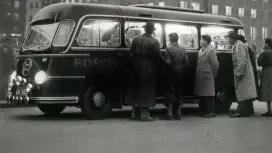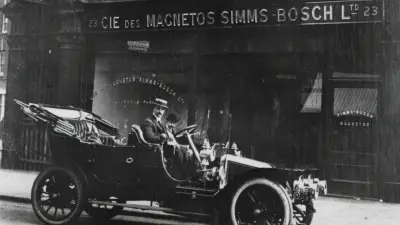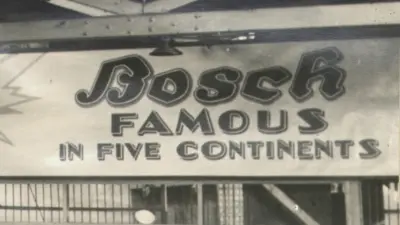A special relationship
125 years Bosch in France
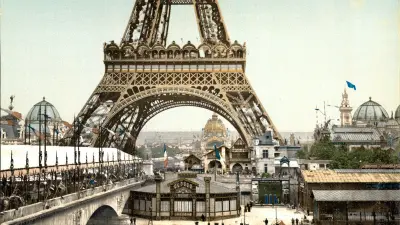
Establishing the French subsidiary in 1899 was a major step forward for the young entrepreneur Robert Bosch. The decision paved the way for the international breakthrough of his most important product, the magneto ignition device. Rapid expansion was followed by numerous setbacks, but the close ties Robert Bosch maintained with France — not just in a business context — have shaped the relationship to Germany’s European neighbor for 125 years.
“In terms of France, I think an independent company will certainly be the best option.”
With his magneto ignition device for automobiles, Robert Bosch had launched a product that he expected to sell extremely well. “I am sure that business with my new product will flourish,” he wrote in March 1898 in a letter to British automotive pioneer Frederick Simms. Bosch recognized that the U.K. and France were more promising markets than Germany at the time, so he arranged the establishment of the Compagnie des Magnétos Simms-Bosch in London with Simms as his business partner. However, Bosch was also drawn to France, where he and Simms agreed in April of the same year to “get things up and running there, the earlier the better.”
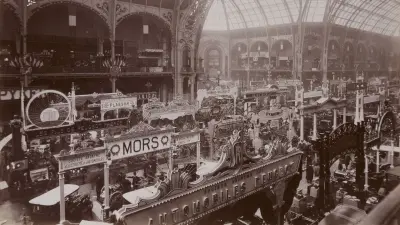
The French market held particular promise, as France was a pioneering presence in the fledgling automotive industry shortly before the start of the 20th century. Paris was considered the center of the automotive world, with more motorized vehicles on the road there than any other city. France was also home to the most automotive manufacturers on the planet.
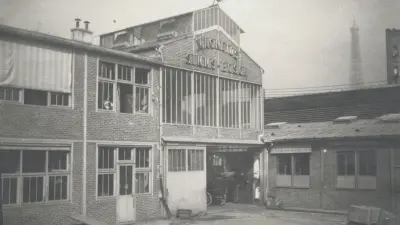
On February 27, 1899, Bosch and Simms founded a sales company registered in Paris called the Automatic Magneto Electric Ignition Co. Shortly afterwards, it was renamed Compagnie des Magnétos Simms-Bosch. Even in the early days, Bosch was already considering manufacturing his magneto ignition systems in France as well, either through a licensee or under his own management. The numbers spoke for themselves: in 1904, more than 80 percent of all automobiles manufactured in France contained a Bosch ignition. In the end, Bosch opted to build his own factory — the first outside of Germany. The production of magneto ignition systems began in 1905 at the newly constructed facility on Rue Violet, in the Parisian district of Grenelle, with the Eiffel Tower in eyeshot.
As Bosch predicted, business thrived. Bosch and Simms parted ways in 1906, and the company changed its name to Société des Magnétos Bosch and continued its expansion. In March 1909, the Société moved into larger office and manufacturing premises on Rue Théophile Gautier in the district of Auteuil and soon opened its first branch office in Lyon.
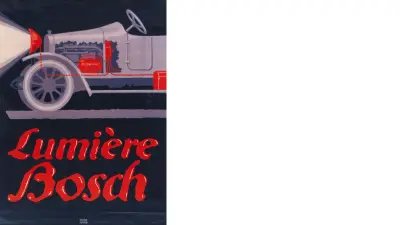
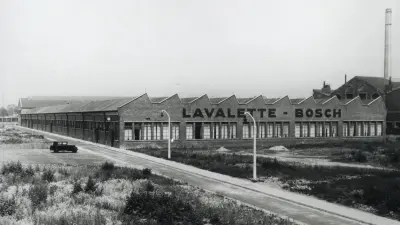
The upswing in France came to an abrupt end with the outbreak of the first world war. All business activity was suspended, and the Bosch company was expropriated by the French government. However, in 1920, Fernand Péan opened up a sales office for Bosch products. From 1928 onwards, Bosch was able to re-establish a manufacturing presence in France through an investment in Count Henri de Lavelette’s company Atéliers de Construction Lavalette. Following the construction of a new factory in the Paris suburb of St. Ouen, the newly named Bosch-Lavalette began producing a broad range of automotive accessories there in 1930. The partnership between the two was harmonious and initially withstood the difficult political circumstances of the time.
The instability and the rise of the Nazi party in Germany didn’t just weigh on the economic ties. Robert Bosch also found little sympathy for his great efforts to promote Franco-German relations. Again and again he called for “Michel and Marianne, ... Germany and France,” to remain shoulder to shoulder. In 1937, though, the anti-France policy of the Nazi regime forced Bosch-Lavalette’s German associates to leave France. After the war, the company was once again expropriated.
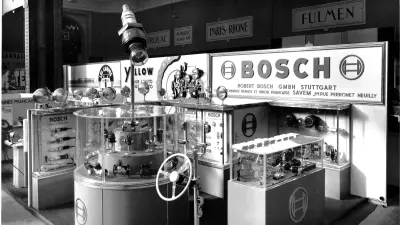
But thanks to the close relationship with Lavalette, with whom Bosch never quite lost touch even during the war years, the company was able to return to France in 1950. With Lavelette’s help, three small sales companies for automotive accessories and refrigerators were opened in the Greater Paris area. In 1958, Bosch had the chance to invest in Ateliérs Lavalette, and, on September 29, 1961, the sales company SAVEM was renamed Robert Bosch (France) S.A.
The two neighbors also began to rekindle their relationship politically too. Franco-German relations, of which Robert Bosch had been such a proponent in the interwar years, began to bear fruit and served as an important milestone on the road towards a united Europe.
In 1962, Robert Bosch GmbH, Atéliers Lavalette, and Précisions Mécanique Labinal S.A. founded the joint venture Les Constructeurs Associés S.A. (LCA) for the manufacture of diesel injection equipment and other automotive parts. Labinal later withdrew from the manufacturing company, leaving Bosch with a majority stake. In 1966, Bosch decided to restructure its operations in the country, merging the sales company Robert Bosch (France) S.A. with the manufacturing arm LCA. The company began trading as Robert Bosch (France) S.A. and relocated its headquarters to the Bosch-Lavalette site on Avenue Michelet in St. Ouen, which was originally set up in 1928. Bosch had completed its return to France with a sustainable umbrella organization and manufacturing expertise.
Over the decades, Bosch expanded its business sectors and divisions to countless locations up and down France. A series of acquisitions and the creation of new operating units cemented Bosch’s position in the French market. The Rodez manufacturing operation set up in the 1960s under LCA also saw further development. In 1973, the then Bosch subsidiary Blaupunkt began manufacturing televisions and car radios, and later automotive technology, in Mondeville. The automotive operations were strengthened in 1974 with the acquisition of SIGMA Diesel in Vénissieux. SIGMA’s industrial technology arm and manufacturing facility in Vénissieux was passed on to Bosch in 2001 as part of Rexroth. Other automotive technology manufacturing sites — in Moulins, Marignier, and Vendôme — were added in the 1990s, as well as heating technology plants in St. Thégonnec and Drancy following the acquisition of e.l.m.Leblanc, and the household appliances manufacturing site in Lipsheim.
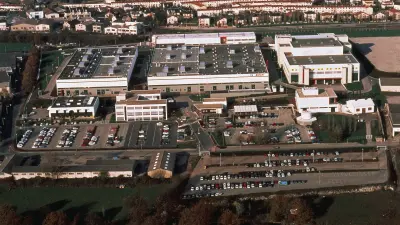
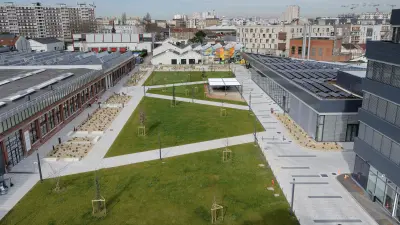
In the anniversary year of 2024, Bosch’s presence in France extends across all of its business sectors at 20 sites, featuring sales, manufacturing, and research and development operations. R&D activities center on the St. Ouen and Sophia Antipolis locations. Over the past few years, St. Ouen has evolved from a manufacturing and sales site to a high-tech campus. Sophia Antipolis has been part of the Bosch Group since 2015 and is home to about 100 experienced experts who develop chips for use in driver assistance components such as video and radar systems. The team has recently moved to state-of-the-art premises.
A look back into the past reveals a story full of highs and lows, but setbacks were always followed by fresh prospects. In France, Robert Bosch took a chance of not only selling his products, but also opening his first international factory there. It proved to be a watershed decision in the further development of his company.
Author: Bettina Simon
